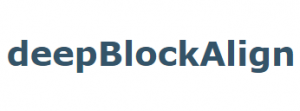Status:
Platform:
Species:
High-throughput sequencing methods allow whole transcriptomes to be sequenced fast and cost-effectively. Short RNA sequencing provides not only quantitative expression data but also an opportunity to identify novel coding and non-coding RNAs. Many long transcripts undergo post-transcriptional processing that generates short RNA sequence fragments. Mapped back to a reference genome, they form distinctive patterns that convey information on both the structure of the parent transcript and the modalities of its processing. The miR-miR* pattern from microRNA precursors is the best-known, but by no means singular, example.
deepBlockAlign introduces a two-step approach to align RNA-seq read patterns with the aim of quickly identifying RNAs that share similar processing footprints. Overlapping mapped reads are first merged to blocks and then closely spaced blocks are combined to block groups, each representing a locus of expression. In order to compare block groups, the constituent blocks are first compared using a modified sequence alignment algorithm to determine similarity scores for pairs of blocks. In the second stage, block patterns are compared by means of a modified Sankoff algorithm that takes both block similarities and similarities of pattern of distances within the block groups into account. Hierarchical clustering of block groups clearly separates most miRNA and tRNA, and also identifies about a dozen tRNAs clustering together with miRNA. Most of these putative Dicer-processed tRNAs, including eight cases reported to generate products with miRNA-like features in literature, exhibit read blocks distinguished by precise start position of reads.
The program deepBlockAlign is available as source code from http://rth.dk/resources/dba/.
gorodkin@rth.dk; studla@bioinf.uni-leipzig.de
Supplementary data are available at Bioinformatics online.[1]








